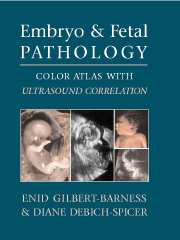Book contents
- Frontmatter
- Contents
- Foreword by John M. Opitz
- Preface
- Acknowledgments
- 1 The Human Embryo and Embryonic Growth Disorganization
- 2 Late Fetal Death, Stillbirth, and Neonatal Death
- 3 Fetal Autopsy
- 4 Ultrasound of Embryo and Fetus: General Principles
- 5 Abnormalities of Placenta
- 6 Chromosomal Abnormalities in the Embryo and Fetus
- 7 Terminology of Errors of Morphogenesis
- 8 Malformation Syndromes
- 9 Dysplasias
- 10 Disruptions and Amnion Rupture Sequence
- 11 Intrauterine Growth Retardation
- 12 Fetal Hydrops and Cystic Hygroma
- 13 Central Nervous System Defects
- 14 Craniofacial Defects
- 15 Skeletal Abnormalities
- 16 Cardiovascular System Defects
- 17 Respiratory System
- 18 Gastrointestinal Tract and Liver
- 19 Genito-Urinary System
- 20 Congenital Tumors
- 21 Fetal and Neonatal Skin Disorders
- 22 Intrauterine Infection
- 23 Multiple Gestations and Conjoined Twins
- 24 Metabolic Diseases
- Appendices
- Index
22 - Intrauterine Infection
Published online by Cambridge University Press: 23 February 2010
- Frontmatter
- Contents
- Foreword by John M. Opitz
- Preface
- Acknowledgments
- 1 The Human Embryo and Embryonic Growth Disorganization
- 2 Late Fetal Death, Stillbirth, and Neonatal Death
- 3 Fetal Autopsy
- 4 Ultrasound of Embryo and Fetus: General Principles
- 5 Abnormalities of Placenta
- 6 Chromosomal Abnormalities in the Embryo and Fetus
- 7 Terminology of Errors of Morphogenesis
- 8 Malformation Syndromes
- 9 Dysplasias
- 10 Disruptions and Amnion Rupture Sequence
- 11 Intrauterine Growth Retardation
- 12 Fetal Hydrops and Cystic Hygroma
- 13 Central Nervous System Defects
- 14 Craniofacial Defects
- 15 Skeletal Abnormalities
- 16 Cardiovascular System Defects
- 17 Respiratory System
- 18 Gastrointestinal Tract and Liver
- 19 Genito-Urinary System
- 20 Congenital Tumors
- 21 Fetal and Neonatal Skin Disorders
- 22 Intrauterine Infection
- 23 Multiple Gestations and Conjoined Twins
- 24 Metabolic Diseases
- Appendices
- Index
Summary
The symptoms and signs and laboratory findings in congenital infections are listed in Table 22.1.
BACTERIAL INFECTIONS
Bacterial infections in the fetus (Figure 22.1) are more frequently recognized than viral, parasitic, or fungal infections. In most cases acquisition of the organism is believed to be from the maternal genital tract by an ascending route. Premature rupture of membranes or a sudden spontaneous abortion may be the first indication of intrauterine infection.
Other routes of infection are:
Hematogenous spread of maternal infection
Iatrogenic infections introduced during prenatal procedures such as amniocentesis
Direct infection from the maternal peritoneal cavity.
In addition, bacteria can be carried asymptomatically in the male urogenital tractandcan infect the conceptusby the ascending route after sexual intercourse in pregnancy.
Infection may occur by access secondary to rupture of membranes. Once bacteria are in the amniotic sac, they incite maternal leukocyte migration from the intervillous space toward the amniotic cavity (Tables 22.1 and 22.2). The accumulation of neutrophils leads to a loss of translucency of the membranes, which become creamy yellow. Most bacteria infect the membranes diffusely. Inhalation and ingestion of infected amniotic fluid by the fetus (amniotic infection syndrome) can be diagnosed microscopically by sectioning of the fetal lungs and stomach, which will contain neutrophils from the amniotic fluid. Infection of the amniotic fluid can result in intrauterine aspiration pneumonia in the fetus or the development of septicemia particularly if the organism is strongly virulent aswith group B streptococci (Figures 22.2 and 22.3). Oranisms most frequently resulting in chorioamnionitis are shown in Table 22.2.
- Type
- Chapter
- Information
- Embryo and Fetal PathologyColor Atlas with Ultrasound Correlation, pp. 601 - 621Publisher: Cambridge University PressPrint publication year: 2004



